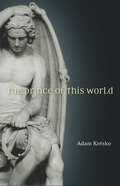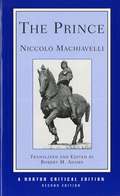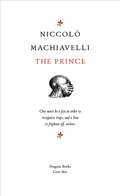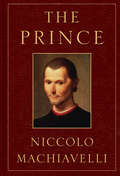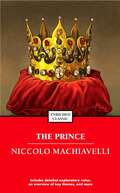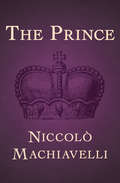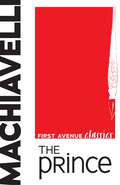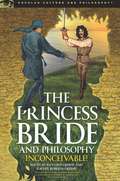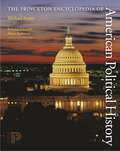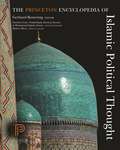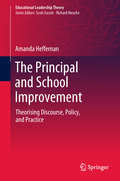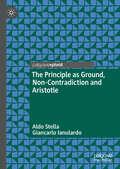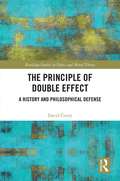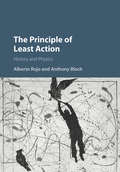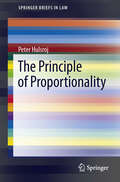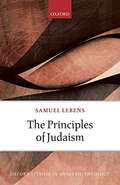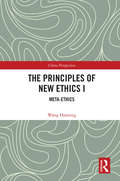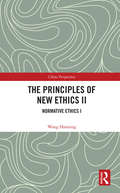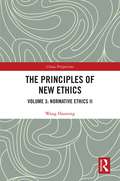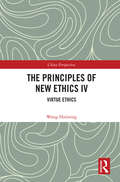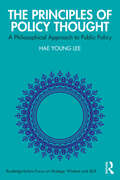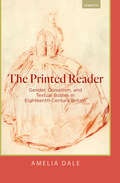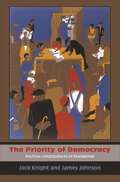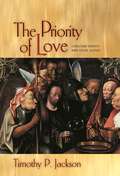- Table View
- List View
The Prince of This World
by Adam KotskoThe most enduring challenge to traditional monotheism is the problem of evil, which attempts to reconcile three incompatible propositions: God is all-good, God is all-powerful, and evil happens. The Prince of This World traces the story of one of the most influential attempts to square this circle: the offloading of responsibility for evil onto one of God's rebellious creatures. In this striking reexamination, the devil's story is bitterly ironic, full of tragic reversals. He emerges as a theological symbol who helps oppressed communities cope with the trauma of unjust persecution, torture, and death at the hands of political authorities and eventually becomes a vehicle to justify oppression at the hands of Christian rulers. And he evolves alongside the biblical God, who at first presents himself as the liberator of the oppressed but ends up a cruel ruler who delights in the infliction of suffering on his friends and enemies alike. In other words, this is the story of how God becomes the devil--a devil who remains with us in our ostensibly secular age.
The Prince: A Revised Translation, Backgrounds, Interpretations, Marginalia (Norton Critical Editions)
by Niccolo MachiavelliAccurate, highly readable, and thoroughly revised for the Second Edition, this translation renders Machiavelli’s 1513 political tract into clear and concise English. <p><p> "Backgrounds" relies entirely upon Machiavelli’s other writings to place this central Florentine in his proper political and historical context. Included are excerpts from The Discourses, a report from a diplomatic mission, a collection of private letters, and two poems from Carnival Songs. <p> "Interpretations" retains three of the previous edition’s seminal essays while adding five selections by Felix Gilbert, Federico Chabod, J. H. Whitfield, Isaiah Berlin, and Robert M. Adams. <p> "Marginalia" is an eclectic collection of writings germane to both Machiavelli and The Prince. Of the eight selections represented, five of them are new to the Second Edition, including Pasquale Villari’s comic portrayal of Machiavelli’s first diplomatic post in 1499, Francesco Guicciardini’s lofty rebuttal to Machiavelli, and a collection of Tuscan Sayings to further the reader’s understanding of this timeless text. <p> An updated Selected Bibliography is also included.
The Prince: Large Print (Penguin Great Ideas)
by Niccolo Machiavelli George BullThroughout history, some books have changed the world. They have transformed the way we see ourselves--and each other. They have inspired debate, dissent, war and revolution. They have enlightened, outraged, provoked and comforted. They have enriched lives--and destroyed them. Now, Penguin brings you the works of the great thinkers, pioneers, radicals and visionaries whose ideas shook civilization, and helped make us who we are. Penguin's Great Ideas series features twelve groundbreaking works by some of history's most prodigious thinkers, and each volume is beautifully packaged with a unique type-drive design that highlights the bookmaker's art. Offering great literature in great packages at great prices, this series is ideal for those readers who want to explore and savor the Great Ideas that have shaped the world. Rejecting the traditional values of political theory, Machiavelli drew upon his own experiences of office in the turbulent Florentine republic to write his celebrated treatise on statecraft. While Machiavelli was only one of the many Florentine "prophets of force," he differed from the ruling elite in recognizing the complexity and fluidity of political life.
The Prince: Literary Touchstone Classic
by Niccolo MachiavelliThe ultimate treatise on statecraft. Machiavelli's work has held such power to shock that he was at one time identified with Satan himself. Published in 1532, it remains relevant—and fascinating—for modern readers.Sayre Street Books offers the world's greatest literature in easy to navigate, beautifully designed digital editions.
The Prince: Literary Touchstone Classic (Enriched Classics)
by Niccolo MachiavelliENDURING LITERATURE ILLUMINATED BY PRACTICAL SCHOLARSHIP EACH ENRICHED CLASSIC EDITION INCLUDES: A concise introduction that gives readers important background information A chronology of the author's life and work A timeline of significant events that provides the book's historical context An outline of key themes and plot points to help readers form their own interpretations Detailed explanatory notes Critical analysis, including contemporary and modern perspectives on the work Discussion questions to promote lively classroom and book group interaction A list of recommended related books and films to broaden the reader's experience Enriched Classics offer readers affordable editions of great works of literature enhanced by helpful notes and insightful commentary. The scholarship provided in Enriched Classics enables readers to appreciate, understand, and enjoy the world's finest books to their full potential. SERIES EDITED BY CYNTHIA BRANTLEY JOHNSON
The Prince: The Prince; Power; The Art Of War
by Niccolò MachiavelliThe world&’s most influential—and controversial—treatise on politicsComposed in exile and published posthumously, The Prince is Niccolò Machiavelli&’s legacy and the foundation of modern political theory. Drawing on his firsthand experiences as a diplomat and military commander in the Florentine Republic, Machiavelli disregards the rhetorical flourishes and sentimentality typically found in sixteenth-century mirrors for princes—guides instructing noblemen in the fine art of ruling—and gets straight to practical matters: how to eliminate rivals, when to use force, whether it is better to be loved or feared. For its cold-blooded candor and unrepentant assertion that immorality can be a political virtue, The Prince was censured and Machiavelli&’s name became synonymous with evil. Yet five centuries&’ worth of political thinkers and leaders, from Thomas Cromwell to Francis Bacon to Napoleon Bonaparte to John Adams to Joseph Stalin, have turned to this slim volume for guidance and inspiration, because its advice on the acquisition and preservation of power contains the wisdom of experience—and, most importantly of all, because it works. This ebook has been professionally proofread to ensure accuracy and readability on all devices.
The Prince: The Prince; Power; The Art Of War (First Avenue Classics ™)
by Niccolò Machiavelli"It is necessary for a prince wishing to hold his own to know how to do wrong, and to make use of it or not according to necessity." In this sixteenth-century treatise to aspiring rulers, Italian author Niccolò Machiavelli offers advice for how to gain and maintain power, unencumbered by values and moral conventions. In this separation of politics and ethics, Machiavelli's revolutionary ideas have often been criticized as ruthless and evil, though some scholars argue that the treatise is a satire. Machiavelli's practical guide for rulers was first published in book form in 1532. This unabridged version is taken from the 1908 translation by W. K. Marriott.
The Princess Bride and Philosophy: Inconceivable!
by Richard Greene Rachel Robison-GreeneThe Princess Bride is the 1987 satirical adventure movie that had to wait for the Internet and DVDs to become the most quoted of all cult classics. <P><P> The Princess Bride and Philosophy is for all those who have wondered about the true meaning of "Inconceivable!," why the name "Roberts" uniquely inspires fear, and whether it's truly a miracle to restore life to someone who is dead, but not necessarily completely dead. The Princess Bride is filled with people trying to persuade each other of various things, and invites us to examine the best methods of persuasion. It's filled with promises, some kept and some broken, and cries out for philosophical analysis of what makes a promise and why promises should be kept. It's filled with beliefs which go beyond the evidence, and philosophy can help us to decide when such beliefs can be justified. It's filled with political violence, both by and against the recognized government, and therefore raises all the issues of political philosophy. Westley, Buttercup, Prince Humperdinck, Inigo Montoya, the giant Fezzik, and the Sicilian Vizzini keep on re-appearing in these pages, as examples of philosophical ideas. Is it right for Montoya to kill the six-fingered man, even though there is no money in the revenge business? What's the best way to deceive someone who knows you're trying to deceive him? Are good manners a kind of moral virtue? Could the actions of the masked man in black truly be inconceivable even though real? What does ethics have to say about Miracle Max's pricing policy? How many shades of meaning can be conveyed by "As You Wish"?
The Princeton Encyclopedia of American Political History. (Two volume set): Volume I and II
by Michael Kazin, Rebecca Edwards, Adam RothmanA comprehensive and authoritative encyclopedia of U.S. political historyAn essential resource for anyone interested in U.S. history and politics, this two-volume encyclopedia covers the major forces that have shaped American politics from the founding to today. Broad in scope, the book addresses both the traditional topics of political history—such as eras, institutions, political parties, presidents, and founding documents—and the wider subjects of current scholarship, including military, electoral, and economic events, as well as social movements, popular culture, religion, education, race, gender, and more.Each article, specially commissioned for this book, goes beyond basic facts to provide readers with crucial context, expert analysis, and informed perspectives on the evolution of American politics. Written by more than 170 leading historians and social scientists, The Princeton Encyclopedia of American Political History gives students, scholars, and researchers authoritative introductions to the subject's most important topics and a first step to further research.Features nearly 190 entries, organized alphabetically and written by a distinguished team of scholars, including Dean Baker, Lewis L. Gould, Alexander Keyssar, James T. Kloppenberg, Patricia Nelson Limerick, Lisa McGirr, Mark A. Noll, Jack N. Rakove, Nick Salvatore, Stephen Skowronek, Jeremi Suri, and Julian E. ZelizerDescribes key political periods and eras, from the founding to the present dayTraces the history of political institutions, parties, and founding documentsExplains ideas, philosophies, and movements that shaped American politicsPresents the political history and influence of geographic regionsDescribes the roles of ethnic, racial, and religious groups in the political processExplores the influence of mass culture, from political cartoons to the InternetExamines recurring issues that shape political campaigns and policy, from class, gender, and race to crime, education, taxation, voting, welfare, and much moreIncludes bibliographies, cross-references, appendixes, a comprehensive index, and more than 50 illustrations and maps
The Princeton Encyclopedia of Islamic Political Thought
by Robert W. Hefner Roxanne L. Euben Timur Kuran David Cook Khaled Fahmy Bernard Haykel Frank Griffel Richard Bulliet Ebrahim Moosa Jane McAuliffeAn indispensable guide to Islamic political thought from Muhammad to the twenty-first centuryThe first encyclopedia of Islamic political thought from the birth of Islam to today, this comprehensive, authoritative, and accessible reference provides the context needed for understanding contemporary politics in the Islamic world and beyond. With more than 400 alphabetically arranged entries written by an international team of specialists, the volume focuses on the origins and evolution of Islamic political ideas and related subjects, covering central terms, concepts, personalities, movements, places, and schools of thought across Islamic history. Fifteen major entries provide a synthetic treatment of key topics, such as Muhammad, jihad, authority, gender, culture, minorities, fundamentalism, and pluralism. Incorporating the latest scholarship, this is an indispensable resource for students, researchers, journalists, and anyone else seeking an informed perspective on the complex intersection of Islam and politics.Includes more than 400 concise, alphabetically arranged entriesFeatures 15 in-depth entries on key topicsCovers topics such as:Central themes and sources of Islamic political thought: caliph, modernity, knowledge, shari'a, government, revival and reformModern concepts, institutions, movements, and parties: civil society, Islamization, secularism, veil, Muslim BrotherhoodIslamic law and traditional Islamic societies: justice, taxation, fatwa, dissent, governance, piety and asceticism, trade and commerceSects, schools, regions, and dynasties: Mu'tazilis, Shi'ism, Quraysh, Mecca and Medina, Baghdad, Indonesia, Nigeria, Central Asia, OttomansThinkers, personalities, and statesmen: Mawardi, Shafi'I, Saladin, Tamerlane, Akbar, Atatürk, Nasser, KhomeiniContains seven historical and contemporary maps of Muslim empires, postcolonial nation-states, populations, and settlementsGuides readers to further research through bibliographies, cross-references, and an index
The Principal and School Improvement: Theorising Discourse, Policy, and Practice (Educational Leadership Theory)
by Amanda HeffernanThis book investigates the localised effects of reform by exploring the impact of a school improvement policy agenda on the work of three experienced principals. It presents three longitudinal case studies within a shared specific leadership context in Queensland, Australia. The case studies enable an exploration of the way the principalship in this context has evolved over time, providing deep insights into the practices and beliefs of three experienced school leaders working in a period of rapid and urgent systemic reform. The nature of global reform policy borrowing means that the research and the findings within this monograph are relevant for international audiences.The book describes a new way to understand and theorise the effects of reform policies and associated pressures on school leaders. Using post-structural theory, it provides a better understanding of the specific effects of reform policy ensembles, particularly when combined with an analysis of the ways policy and discourse work together at a wider level to create an environment that disciplines the principalship. Further, it sheds lights on the means of complying with or contesting policy influences and how the work of leaders has changed over time.
The Principle as Ground, Non-Contradiction and Aristotle
by Aldo Stella Giancarlo IanulardoNumerous thinkers have considered the Principle of Non-Contradiction, but none has clearly identified its inherent limitation: that it is itself only a formal principle. This book shows that negation plays a fundamental role both in the constitution of the principle and in the affirmation of its value, which consists in its undeniability. Since it is a formal negation, it is extrinsic to the negated in such a way that it is configured as a negation only insofar as it is applied to something. On the basis of this analysis, it is shown that it is possible to reverse the usual philosophical perspective: it makes no sense to speak of proof of the principle, but only of proof by virtue of the principle. This book is essential reading for all scholars and researchers of theoretical philosophy and Aristotle.
The Principle of Double Effect: A History and Philosophical Defense (Routledge Studies in Ethics and Moral Theory)
by David ČernýThis book offers a comprehensive history of the principle of double effect and its applications in ethics. Written from a non-theological perspective, it makes the case for the centrality of the double effect reasoning in philosophical ethics. The book is divided into two parts. The first part thoroughly examines the history of double effect reasoning. The author’s history spans from Thomas Aquinas’s opera omnia to the modern and influential understanding of the principle known as proportionalism. The second part of the book elucidates the principle and addresses various objections that have been raised against it, including those that arise from an in-depth discussion of the trolley problem. Finally, the author examines the role of intentions in ethical thinking and constructs a novel defense of the principle based on fine distinctions between intentions. The Principle of Double Effect: A History and Philosophical Defense will be of interest to scholars and advanced students working in moral philosophy, the history of ethics, bioethics, medical ethics, and the Catholic moral tradition.
The Principle of Hope: Volume 1 (Studies In Contemporary German Social Thought)
by Ernst Bloch Paul Knight Neville Plaice Stephen PlaiceThe Principle of Hope is one of the great works of the human spirit. It is a critical history of the utopian vision and a profound exploration of the possible reality of utopia. Even as the world has rejected the doctrine on which Bloch sought to base his utopia, his work still challenges us to think more insightfully about our own visions of a better world. <p><p> The Principle of Hope is published in three volumes: Volume 1 lays the foundations of the philosophy of process and introduces the idea of the Not-Yet-Conscious - the anticipatory element that Bloch sees as central to human thought. It also contains a remarkable account of the aesthetic interpretations of utopian "wishful images" in fairy tales, popular fiction, travel, theater, dance, and the cinema. <p><p> Volume 2 presents "the outlines of a better world." It examines the utopian systems that progressive thinkers have developed in the fields of medicine, painting, opera, poetry, and ultimately, philosophy. It is nothing less than an encyclopedic account of utopian thought from the Greeks to the present. <p><p> Volume 3 offers a prescription for ways in which humans can reach their proper "homeland," where social justice is coupled with an openness to change and to the future.
The Principle of Least Action: History And Physics
by Alberto Rojo Anthony BlochThe principle of least action originates in the idea that, if nature has a purpose, it should follow a minimum or critical path. This simple principle, and its variants and generalizations, applies to optics, mechanics, electromagnetism, relativity, and quantum mechanics, and provides an essential guide to understanding the beauty of physics. <P><P>This unique text provides an accessible introduction to the action principle across these various fields of physics, and examines its history and fundamental role in science. It includes - with varying levels of mathematical sophistication - explanations from historical sources, discussion of classic papers, and original worked examples. The result is a story that is understandable to those with a modest mathematical background, as well as to researchers and students in physics and the history of physics.<P> Drawing from the original sources, this book discusses many of the key ideas in this area from both the scientific and historical perspectives to paint a broad picture of this unifying principle.<P> Discusses classic papers in a way that is accessible to the modern reader and will appeal to those who are interested in how physical concepts are generated.<P> Includes worked examples to show how the principle works in practice.
The Principle of Proportionality
by Peter HulsrojThe book applies the principle of proportionality to a number of conventional wisdoms in the social sciences, such as in dubio pro reo and the assumption that a crime is always a crime; that you must go to war if instructed to do so. Individuals and states are not obliged to come to the aid of stricken individuals and states. The book is organised in seven chapters, each dealing with a self-standing theme related to proportionality.
The Principles Of Judaism (Oxford Studies In Analytic Theology Ser.)
by Samuel LebensSamuel Lebens takes the three principles of Jewish faith, as proposed by Rabbi Joseph Albo (1380-1444), in order to scrutinize and refine them with the toolkit of contemporary analytic philosophy. What could it mean for a perfect being to create a world from nothing? Could our world be anything more than a figment of God's imagination? What is the Torah? What does Judaism expect from a Messiah, and what would it mean for a world to be redeemed? These questions are explored in conversation with a wide array of Jewish sources and with an eye towards diverse fields of contemporary research, such as cosmology, philosophical logic, the ontology of literature, and the metaphysics of time. The Principles of Judaism articulates the most fundamental axioms of Orthodox Judaism in the vernacular of contemporary philosophy.
The Principles of New Ethics I: Meta-ethics (China Perspectives)
by Wang HaimingFrom Descartes to Spinoza, Western philosophers have attempted to propose an axiomatic systemization of ethics. However, without consensus on the contents and objects of ethics, the system remains incomplete. This fourvolume set presents a model that highlights a Chinese philosopher’s insights on ethics after a 22-year study. Three essential components of ethics are examined: metaethics, normative ethics, and virtue ethics. This volume mainly studies meta- ethics. The author not only studies the fi ve primitive concepts of ethics— “value,” “good,” “ought,” “right,” and “fact”— and reveals their relationship, but also demonstrates the solution to the classic “Hume’s guillotine”— whether “ought” can be derived from “fact.” His aim is to identify the methods of making excellent moral norms, leading to solutions on how to prove ethical axioms and ethical postulates. Written by a renowned philosopher, the Chinese version of this set sold more than 60,000 copies and has exerted tremendous infl uence on the academic scene in China. The English version will be an essential read for students and scholars of ethics and philosophy in general.
The Principles of New Ethics II: Normative Ethics I (China Perspectives)
by Wang HaimingFrom Descartes to Spinoza, Western philosophers have attempted to propose an axiomatic systemization of ethics. However, without consensus on the contents and objects of ethics, the system remains incomplete. This four-volume set presents a model that highlights a Chinese philosopher’s insights on ethics after a 22-year study. Three essential components of ethics are examined: metaethics, normative ethics, and virtue ethics. In this volume, the author sets out to discuss morality, and shows how the reasoning behind it can be both good and bad for human society from various perspectives. A system of an ultimate standard of morality is introduced and it is shown that where there are conflicts between different moral norms that cannot be compromised, people undoubtedly sacrifice less important moral norms to follow more fundamental and important moral norms or principles.The Chinese version of this set sold more than 60,000 copies and has exerted tremendous influence on the academic scene in the People’s Republic. The English version will be an essential read for students and scholars of ethics and philosophy in general.
The Principles of New Ethics III: Normative Ethics II (China Perspectives)
by Wang HaimingFrom Descartes to Spinoza, Western philosophers have attempted to propose an axiomatic systemization of ethics. However, without consensus on the contents and objects of ethics, the system remains incomplete. This four-volume set presents a model that highlights a Chinese philosopher’s insights on ethics after a 22 year study. Three essential components of ethics are examined: metaethics, normative ethics, and virtue ethics. This volume is the second part of the discussion on normative ethics. The author analyzes humanity, liberty, justice, happiness, and systems of moral rules. He puts forward 26 value standards that construct a system of measuring state instruction; reveals the relationship between humanity, liberty and justice; puts forward three objective laws of happiness; and discusses the goodness of important moral rules, such as honesty, self-respect and courage. This set is an essential read for students and scholars of ethics and philosophy in general.
The Principles of New Ethics IV: Virtue Ethics (China Perspectives)
by Wang HaimingFrom Descartes to Spinoza, Western philosophers have attempted to propose an axiomatic systemization of ethics. However, without consensus on the contents and objects of ethics, the system remains incomplete. This four-volume set presents a model that highlights a Chinese philosopher’s insights on ethics after a 22-year study. Three essential components of ethics are examined: metaethics, normative ethics, and virtue ethics. In this volume, the author analyzes the relationship between people’s sense of reputation, the political and economic status of a nation, and the observation of virtue ethics and he argues that reputation can encourage people to conform to virtue ethics. In addition, a nation’s political and economic status is closely connected to people’s virtue ethics. That is, people will have higher virtue ethics when constitutional democracy, a market economy without government control, freedom of speech, and the moral system of liberalism and egalitarianism are established in a nation. This title is an essential read for students and scholars of ethics and philosophy in general.
The Principles of Policy Thought: A Philosophical Approach to Public Policy (Routledge-Solaris Focus on Strategy, Wisdom and Skill)
by Hae Young LeePolicy thought integrates the “why” of political philosophy and the “how” of public policy formulation. Lee outlines five key principles for the development of policy thought:• The Principle of Policy Statism• The Principle of Policy Goodness• The Principle of Policy Balance• The Principle of Policy Practicality• The Principle of Policy Humans: Interpenetrated Policy Humans with Non-humans Each principle is derived from a combination of Confucian and other East Asian philosophies, as well as contemporary Western political philosophy. In combination they offer an innovative approach to formulating, configuring and assessing public policy, with ethics and efficacy. An essential guide to incorporating big picture philosophical questions into pragmatic policy for students, practitioners and scholars of public policy and administration.
The Printed Reader: Gender, Quixotism, and Textual Bodies in Eighteenth-Century Britain (Transits: Literature, Thought & Culture 1650-1850)
by Amelia DaleThe Printed Reader explores the transformative power of reading in the eighteenth century, and how this was expressed in the fascination with Don Quixote and in a proliferation of narratives about quixotic readers, readers who attempt to reproduce and embody their readings. Through intersecting readings of quixotic narratives, including work by Charlotte Lennox, Laurence Sterne, George Colman, Richard Graves, and Elizabeth Hamilton, Amelia Dale argues that literature was envisaged as imprinting—most crucially, in gendered terms—the reader’s mind, character, and body. The Printed Reader brings together key debates concerning quixotic narratives, print culture, sensibility, empiricism, book history, and the material text, connecting developments in print technology to gendered conceptualizations of quixotism. Tracing the meanings of quixotic readers’ bodies, The Printed Reader claims the social and political text that is the quixotic reader is structured by the experiential, affective, and sexual resonances of imprinting and impressions. Published by Bucknell University Press. Distributed worldwide by Rutgers University Press.
The Priority of Democracy: Political Consequences of Pragmatism
by James Johnson Jack KnightWhy democracy is the best way of deciding how decisions should be madePragmatism and its consequences are central issues in American politics today, yet scholars rarely examine in detail the relationship between pragmatism and politics. In The Priority of Democracy, Jack Knight and James Johnson systematically explore the subject and make a strong case for adopting a pragmatist approach to democratic politics—and for giving priority to democracy in the process of selecting and reforming political institutions.What is the primary value of democracy? When should we make decisions democratically and when should we rely on markets? And when should we accept the decisions of unelected officials, such as judges or bureaucrats? Knight and Johnson explore how a commitment to pragmatism should affect our answers to such important questions. They conclude that democracy is a good way of determining how these kinds of decisions should be made—even if what the democratic process determines is that not all decisions should be made democratically. So, for example, the democratically elected U.S. Congress may legitimately remove monetary policy from democratic decision-making by putting it under the control of the Federal Reserve.Knight and Johnson argue that pragmatism offers an original and compelling justification of democracy in terms of the unique contributions democratic institutions can make to processes of institutional choice. This focus highlights the important role that democracy plays, not in achieving consensus or commonality, but rather in addressing conflicts. Indeed, Knight and Johnson suggest that democratic politics is perhaps best seen less as a way of reaching consensus or agreement than as a way of structuring the terms of persistent disagreement.
The Priority of Love: Christian Charity and Social Justice (New Forum Books #57)
by Timothy P. JacksonThis book explores the relation between agape (or Christian charity) and social justice. Timothy Jackson defines agape as the central virtue in Christian ethical thought and action and applies his insights to three concrete issues: political violence, forgiveness, and abortion. Taking his primary cue from the New Testament while drawing extensively from contemporary theology and philosophy, Jackson identifies three features of Christian charity: unconditional commitment to the good of others, equal regard for others' well-being, and passionate service open to self-sacrifice for the sake of others.Charity, prescribed by Jesus for his disciples and named by Saint Paul as the "greatest" theological virtue, is contrasted with various accounts of justice. Jackson argues that agape is not trumped by justice or other goods. Rather, agape precedes justice: without the work of love, society would not produce persons capable of merit, demerit, and contract, the elements of most modern conceptions of justice. Jackson then considers the implications of his ideas for several questions: the nature of God, the relation between Christian love and political violence, the place of forgiveness, and the morality of abortion. Arguing that agapic love is to be construed as a gift of grace as well as a divine commandment, Jackson concludes that love is the "eternal life" that makes temporal existence possible and thus the "first" Christian virtue. Though foremost a contribution to Christian ethics, Jackson's arguments and the issues he takes up will find a broader readership.
